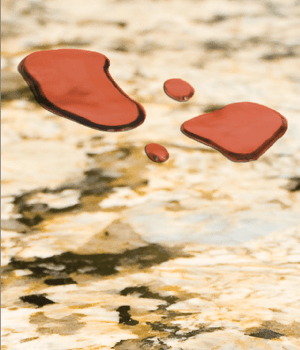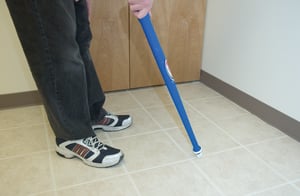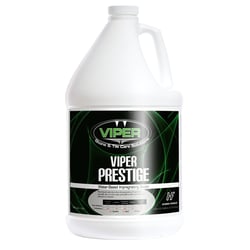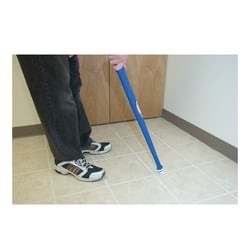Sealers may be topical (meaning they stay on the surface) or impregnating (also called penetrating). Topical sealers give gloss or shine initially but tend to wear away in traffic areas leaving the floor with a blotchy appearance. Depending upon the specific sealer, they can also be difficult to completely remove from grout lines or porous tiles.
Topical sealers are made from a variety of materials including urethane and acrylic. Urethane is very durable. Acrylic is easier to apply and levels better. Some urethane may darken or yellow with age. Urethane can be very difficult to remove. Be wary if asked to remove the finish from stone or grout. The job may be more challenging than you anticipate. Testing will help you to know what to expect.
Penetrating sealers do not normally change the appearance of the tile or the grout. They do fill the many pores, capillaries, and void areas in the grout to reduce how much staining materials can soak in. It makes the grout easier to clean in the future. There are penetrating sealers made for porous stones such as slate or porous tile such as Saltillo that increase the contrast of the colors making the colors appear more vivid and jump out. These are called enhancing sealers or color enhancing sealers.
Sealers may be suspended, carried in water, or a solvent. Water-based or water-carried sealers are less expensive and have much fewer health or safety concerns. Water-based sealers are generally preferred in most situations. Solvent-based sealers must be used in well-ventilated areas, sometimes with a respirator. No unnecessary people or pets should be around. Keep away from heat or sparks. Solvent sealers penetrate deeper and therefore can last longer in some situations. As the liquid carrier evaporates, most sealers form polymers or chains of molecules that strengthen the sealer and form a barrier. Once the water or solvent has evaporated, what remains is the sealer which can be the same regardless of being carried in water or solvent.
Any sealer can gradually be broken down by repeated cleaning with solvents or high pH (alkaline cleaners). For normal day-to-day maintenance without damaging the sealer, I suggest cleaning with a neutral or near-neutral cleaner that has a detergent or surfactant but no solvents. When heavier cleaning is required, use a product with solvents and/or greater alkalinity.
Applying Sealers
Sealers should be applied to dry or nearly dry grout or stone. The surface does not need to be 100% dry, but the drier the better, certainly no standing water. If there is water in the grout, the water-based sealer gets diluted. When using a solvent-based sealer, the sealer will float on top of the water that is still present and not penetrate as deeply. Thus it loses its key advantage.
Penetrating sealers should only be applied to porous surfaces where they will be absorbed. Since glazed ceramic, porcelain, and similar tile will not absorb sealer, the sealer should be applied to the grout only. There are several tools to do this. None are perfect. Controlling how much sealer goes on and getting the sealer only on the grout issue. I prefer a tool called Grout Wand that is like a plastic baseball bat. It is filled with a sealer. Rolling a wheel applies the sealer. The more downward pressure the more sealer is dispensed.
When the sealer gets on the tile, give it 5 to 10 minutes to start to dry. A partially dry sealer is easier to wipe off than a fresh wet sealer. But if it dries completely, it is very hard to remove. So, don't wait too long. Exactly how long depends upon temperature, humidity, airflow, and so forth, but usually between 5 and 10 minutes.
Some porous tiles and most natural stone floors should be sealed. When you are sealing the entire floor and not just the grout, the sealer can be applied like mopping a floor. Put down some sealer and use a finishing tool or a clean mop that will not leave lint and spread it around. Terry cloth or microfiber in various sizes are available.
If sealer soaks in quickly, a second application is probably needed. Your goal is to apply enough sealer to fill the voids but not too much sealer so that any dries on the surface. Stone, being natural, has a lot of variations. If the sealer is not penetrating some areas, use your applicator or a squeegee to move the excess sealer to another area. If the sealer is quickly being absorbed and drying in some areas, move or add additional sealer there.
When applying a sealer to large areas of grout, an option is to spread the sealer across the whole floor; Use a squeegee (I like moss rubber) to push it off the tiles and into the grout lines. A second person comes behind after 5 to 10 minutes and uses a buffer and white or beige pad to remove any remaining sealer from the surface of the tile before it completely dries. This uses up more product but saves labor time because you can go so much faster than just putting the sealer on the grout lines.
by Scott Warrington
Featured Products

Hydro-Force, Viper Prestige Impregnating Sealer, Water Based, 1 Gallon

